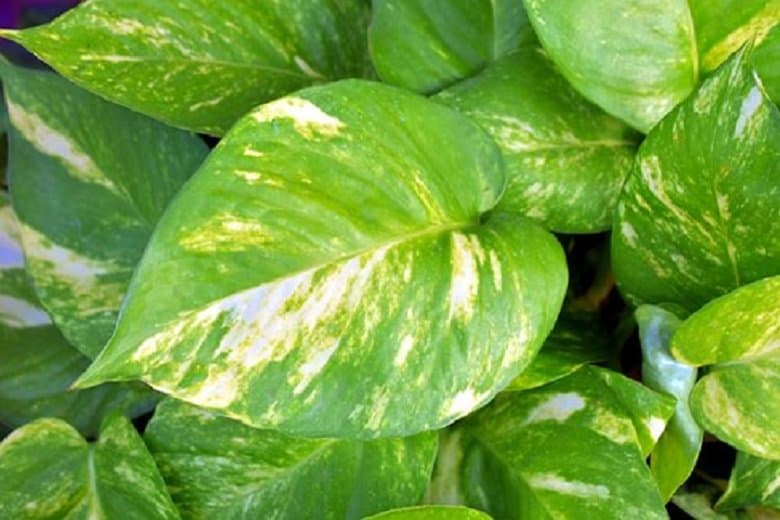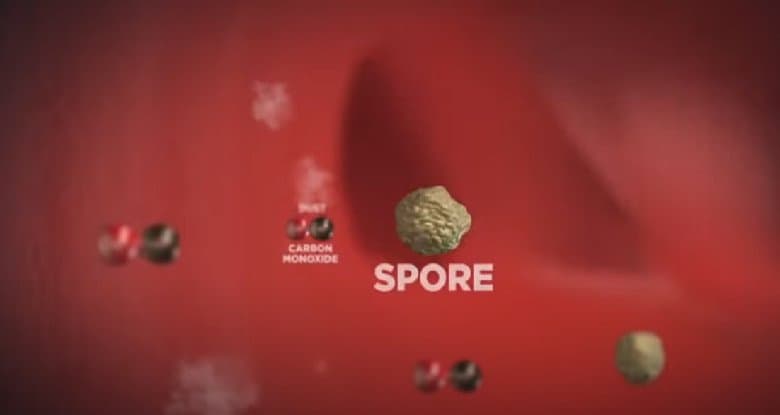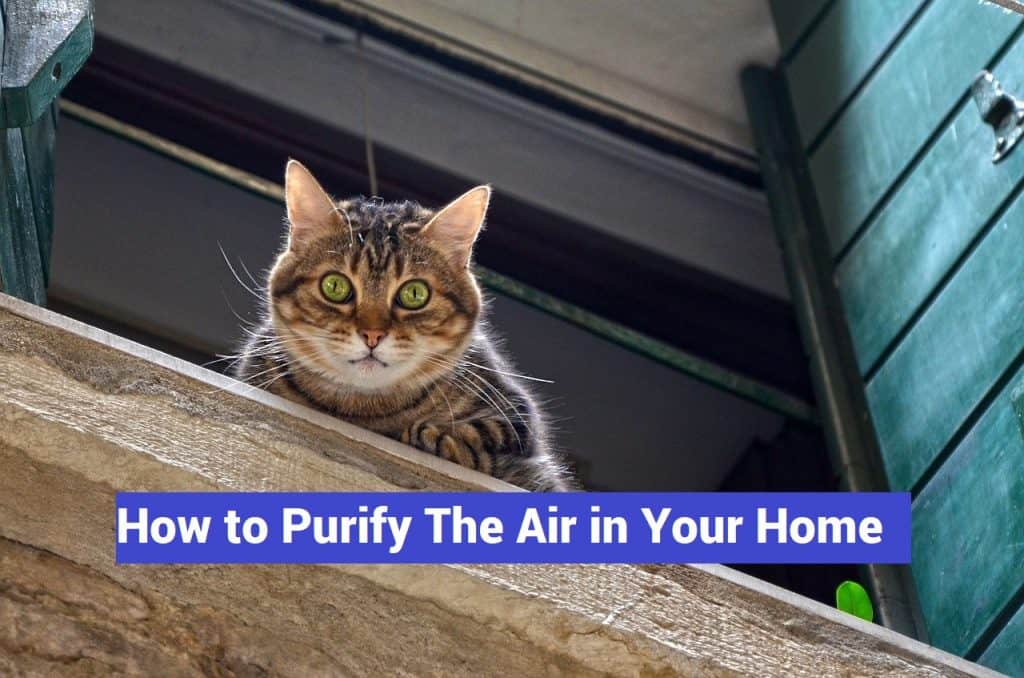When we think about poor air quality, many of us consider the air pollution we are exposed to outdoors. Fewer of us consider the air quality in our home as having an impact on our health. But the air in our homes is important because we are exposed to it every day. Now, let’s get to facts and how to purify the air in your home.
Many chemicals are used in the creation of homes, from paint to carpet to mattresses and cleaning products. Other contaminants in the air include pet dander, carbon dioxide and other volatile chemicals known as VOC’s. These are just a few of the toxins that are found in the air indoors.
The air quality inside depends on a variety of factors including the location of the home or building, air pollution output, proximity to large cities, or living near farms that use chemical sprays.
Buildings that are damp can also facilitate mold growth and bacteria proliferation. Living in a damp or moldy location can increase breathing issues and asthma attacks and can also increase other health conditions that are not as obviously associated with poor air quality, like skin issues or headaches.
Various factors influence indoor air quality including dusk, outdoor air pollution, pet dander, off-gassing from paint, mattresses, carpet etc., chemical cleaners, gas stoves, mold, and dusty furnishings.
Dust mites live in mattresses, furniture and carpet and should be cleaned regularly to eliminate and reduce their presence in the home.
There are various ways to begin tackling the air quality in your home. Some simple solutions include the following:
- Invest in a quality vacuum – carpets contain allergens and pollution, so minimizing the carpet in the home should help. Maintain a cleaning protocol for carpets and surrounding areas, and keep clean drapes, blinds, and bedding. Don’t wear shoes in the house as they can track dirt and pollen into the home. There are many options to choose for anti-allergen vacuum cleaners as you may choose from Amazon such as the following one:

2. Keep your pets clean – pets can also track mold, dirt, and allergens into the home. If they are regularly groomed and bathed, they will carry less dander and pet hair into the home.
3. Use beeswax candles – candles made of natural beeswax can actually purify the air by creating negative ions in the home which neutralize contaminants. Just be sure not to use any chemical fragrances which can be irritating to the body. Beeswax candles can help to remove allergens from the air. Please try to choose natural Beeswax candles.

4. Reduce mold exposure and growth – many buildings have a tendency toward damp conditions which is a prime place for mold to grow. Find any sources of mold and remedy them as soon as possible. Remove any moldy items from the home or thoroughly clean surfaces that can be salvaged like metal or glass.
How do you keep mold out of buildings and homes?
Inspect buildings for evidence of water damage and visible mold as part of routine building maintenance, Correct conditions causing mold growth (e.g., water leaks, condensation, infiltration, or flooding) to prevent mold growth. Inside your home, you can control mold growth by:
- Controlling humidity levels;
- Promptly fixing leaky roofs, windows, and pipes;
- Thoroughly cleaning and drying after flooding;
- Ventilating shower, laundry, and cooking areas.
5. Eliminate VOCs – many fabrics and building materials including paints, flooring, drywall, and more contain volatile compounds called VOCs. These can cause health issues like headaches, skin rashes, fatigue, dizziness, and may even lead to cancer. Choose low VOC paint, natural products, and organic materials when working on your home improvements. You may need an air purifier with the appropriate capacity for your room and one that’s equipped with a True HEPA Carbon filter.

6. Add air purifying plants – many plants can clean the air indoors and can take up VOCs. Some plants are better than others at air purification, so check with a local nursery or do research to invest in the best air purifying plants. But, although plants are technically removing a minute amount of airborne toxins, to have it compete with air exchange, you would need an infeasible amount of plants such as that you would require around 10 plants per square foot (i.e. in a 500-square foot apartment, that’s 5.000 plants).

7. Use a salt lamp – salt lamps are made from Himalayan salt crystals and produced negative ions that can clean the air. Salt lamps are “natural ionizers,” meaning they change the electrical charge of the circulating air. Salt lamps produce a beautiful organic glow and offer a more natural lighting solution that does not use disruptive blue lights. If you decide to buy one, please try to choose the one that’s made from natural Himalayan salt crystals.

Yet, there is little support for this practice, and it’s not clear whether it is safe or effective for people with respiratory conditions. Also, conducted tests on air ionizers, which emit high levels of negative ions, have not yet been shown to benefit people with asthma or improve respiratory efficiency.
Also, studies on salt lamps have not yet examined the effects on sleep; however, a review of the effects of air ionization on relaxation and sleep didn’t find any evidence of a beneficial effect.
These are just a few easy ways to implement cleaner air quality and eradicate unnatural chemicals and compounds from the air for better health.
Knowledge Point:
How effective are air purifiers as a solution for how to purify the air in your home?
Demand for air purifiers has spiked during the COVID-19 pandemic as scientists warn that the coronavirus might be spread through the air. But will air purifiers really protect you from COVID-19? And do you really need one at home? Talking Point finds out what other harmful substances are lurking unseen in the air, inside our homes. How effective are air purifiers for Coronavirus?
You may find the detailed transcript for the video below:
So, it feels great being out here in the open, but studies show that in reality we spend 90% of our time indoors. Now, with various studies pointing to Covid-19 being potentially airborne, is it time we pay more attention to the air? We are breathing at home.
I bought myself an air purifier about five years ago when Singapore was dealing with the regional haze crisis, but you know what I haven’t been using it. It’s been sitting here in my storeroom. Oh, I think, for the past three years.
So in this episode of a talking point, I want to find out if we really need air purifiers in our home and just how effective are these things? Sales for air purifiers surged when Singapore was hit by the regional haze in 2018 and when the Covid-19 pandemic struck early this year demand spiked again retailers say sales went up by up to five times compared with the same period last year.
Do you have any air purifiers at all yeah? I do. I do have one at home. I ran the home studio, so it’s very important to keep the air clean at home. What made you get them to worry about dust and allergies, and do you find that it’s been effective when you breathe, you actually feel that the air is thinner, especially the smell you put it there.
The smell will go on there’s, less dust, and what I understand the filter can trap bacteria and viruses there’s growing evidence that suggests Covid-19 is airborne. This means that if I am in a poorly ventilated, enclosed space with an infected person, I might contract the virus too.
Of course, we’re, looking at an extended exposure of about 30 minutes, but still, it’s better to be safe than sorry. I want to know if air purifiers can rid the air of the coronavirus, so I’m. Going to the one place that will have all the answers about Covid-19.
Singapore’s National Center for Infectious Diseases. Dr. specialized, in controlling and preventing infection, and was involved in developing a test to check symptoms for Covid-19 infections.
So is the air purifier able to catch those particles from the coronavirus based on our current understanding, uh, the main modality of transmission of Covid-19 remains primarily through respiratory droplets, as well as contact transmission.
However, there may be certain circumstances in which airborne transmission of Covid-19 could occur, and this may be in a setting where there are a lot of people within a very enclosed space. Doing very specific activities such as speaking in very loud voices or singing most of the air filters that we are talking about these days.
Pride themselves on having a HEPA filter and the HEPA filter holds itself to a very high standard in that it’s specified to filter out up to, I think, 99.97 % of the particles. This includes infective pathogens and viruses, and so I guess an air purifier with a HEPA filter would probably be quite effective, especially if the air sort of circulates through the air purifier multiple times.
However, having said that, I think we should be mindful not to think of the air purifier as a magic bullet. I think the overall strategy to reduce one’s risk really would be to include things like frequent hand, washing wiping of surfaces, air purifier itself, while it may provide an adjunct to improving the air quality.
Shouldn’t, be thought of as like the magic bullet to keeping ourselves safe from infective pathogens. In general, basic air purifiers come with what’s called HEPA filters and activated carbon HEPA filters are a grader filter that can remove microscopic particles in the air.
Together with the activated carbon, these air purifiers claim to remove harmful substances from the air by up to 99.9 percent. An air purifier with a heaper filter may protect us from Covid-19 in the air, but, as I’ve learned it’s, no magic bullet for Covid-19. No, it isn’t.
The only thing that’s lurking in our air, many studies have reported that the air inside our homes is far dirtier than the air outside shocking isn’t it, professor tom cox. Why has been studying indoor air quality for more than 30 years and he’s going to tell me what’s in every breath I take.
So professor, tell me what would be some of the most common contaminants we find in the air. I think we broadly can classify into three different categories. The first is what we call the physical contaminants, so these principally dust the second category.
I think that much more pervasive it is gaseous, it flows all around the place and we basically briefed it in, and the third are things which are basically living organisms. What we call the biological category and from these three categories, where did they come from uh?
Let’s take this, for example, the physical ones. I’m sure that this is a very common household vacuum cleaner yeah. One of the things that we must understand is that when it sucks in the dust you can see the filter inside over here, the filter does not remove everything, and this means sucking must come out and unfortunately, the finer does basically follow the airstream out the final ones actually become airborne, and this final one’s, actually much more damaging because they’re small, they remain airborne and they actually go much deeper in their lungs.
The other part that i’m going to mention, may scare you a little bit okay when it is actually being sucked through this. It actually churns that grinding, so the bigger particles become smaller particles.
Imagine your cockroach egg and the very thing that you actually don’t want this, can ground and then maybe become very small particles they get born. So when we vacuum our homes, we remove the dust that is visible to the eye, but inadvertently release finer pollutants which are invisible back into the air.
To avoid this proftam recommends using a vacuum cleaner with a water filter. The water will prevent finer pollutants from being released back into the air. What else contributes to pollutants in the air? Gaseous pollutants are one of the most important exposures that we must guard against thick cooking, for example.
Firstly, there are two types of cooking one uses gas or town gas, which is still quite common, but you think the source of the heat is really because of the combustion of the town, gas, okay, and that combustion will produce by-products and we are inhaling them.
Not all of which are actually good for the body. Are there any other areas that would be of concern in our home? I think there’s, one last category that I mentioned, which is the biologicals. There are things that are very minor in nature: the bacteria, in particular, most so, if you smell something, musky is actually an indication that it is mold infested and some of this mold they produce chemicals that are toxic to the body.
So it seems that the air in our homes is a hot bit of dangerous contaminants. Small debris such as dust, harmful gases such as carbon monoxide, and spores from the mold. They can enter our lungs, leading to respiratory problems and chronic conditions such as heart disease.

And these days, air purifiers don’t just come with heater filters. They come with ionizers with UV light with ozone generators and they claim to kill microorganisms and remove harmful chemicals, all of which can cost a hundred to over a thousand Singapore dollars.
The bigger the coverage area, the higher the cost so which one do I choose for my home. Only one way to find out. I’m putting this machine to the test. I’ve discovered that air purifiers with the HEPA filter can help filter out the much-feared Covid-19 virus from the air.
But how effective is it against regular dust, gas, and biological pollutants such as more air purifiers, which now come with add-ons like ultraviolet light? Ozone generators and ionizers, but do I really need them? Helping me figure this out is professor David Chong.
He’s, done extensive research on ways to improve indoor air quality in the tropics. I’m meeting him today with Muhammad Jafri Ahmad Bajuri. He’s been thinking of getting an air purifier for his home because his father-in-law and wife both suffer from asthma.
He believes an air purifier can rid his home of allergens. Like dust which usually triggers an attack, but he’s, not quite sure, yet if it’s worth the investment, there are so many air purifiers out in the market these days.
How should I go about choosing one it’s, my personal opinion, I would say the conventional HEPA filter, okay, right with activator carbon. What is important is really something that is uh have been tested and proven, which is the conventional HEPA filter and what we see in the back.
Here I mean these are the dirt, especially the outer frying particles that can be arrested by this HEPA filter as the dirt accumulates over time. The filter degrades and has to be replaced with a new one.
Very often, some of these come with not just the HEPA filter but also activated carbon activated. Carbon does absorb pollutants from the air. In fact, we use it a lot in a commercial building when they have basically odor.
They may to some extent remove some of the chemicals, but do take note. Our environment is very hot and humid, so moisture content in the air is relatively high. They will deteriorate with time. I’ve heard about others.
You know purifiers coming with things like ozone, generator, ionized, air, or UV light. Do I need them in my air purifier there’s, a word of caution that they may be effective, but they’re, also side effects for some of them?
You need to check with the professionals if you want to use those technologies, while ultraviolet light can kill harmful microorganisms. It can also hurt our eyes and skin injuring the cornea and increasing the risk of skin cancer.
Ionizers and ozone generators, on the other hand, produce ozone, and breathing in too much ozone can affect how our lungs function and make them more prone to infection. So, for a home setting, all we need is essentially a basic HEPA filter with activated carbon one that is suited for homes.
Bedroom costs about 500 Singapore dollars only one thing left to do and that’s to test this. In Geoffrey’s home and to see just how effective it is in removing dust and other pollutants like bacteria and gases which could be dangerous to our health.
I am here with the air purifier I’m, not doofy’s only visitor today, Joey Fung is an independent air quality inspector. She runs tests to find out how many contaminants there are in the air in an enclosed space.
Hi, how are you? Joey, today she’s, going to help me test the effectiveness of the air purifier by taking air pollutant readings in Duffy’s home before and after we run the machine. This is my bedroom okay.
So this is where you spend a lot of time, and I guess you want the air to be good. You know joey, how do we check the air quality in this room? Firstly, the AC has to be turned on and the door has to be closed because we need to contain the space.
So this is to test your temperature relative, humidity and come out outside, for this is air velocity and velocity like whether it’s. A breeze or not exactly whether it’s stuffy, whether that’s, strong okay.
So this is carbon monoxide. This will be testing for VOCs and formula height, harmful gases. If the results are bad, we should be concerned about that one, and this is also for a dust level, your pm 2.
5 and your pm10. So you can tell whether this is a dusty roof. Yes, we can, especially if you know you have sinuses asthmatic. You know the triggers, you want to know your dust level. Oh yeah, all this dust problem.
Next JGeoey sets up a device that can tell how much mole and bacteria there is in the room. Basically, we will put the agar plate inside, and then it will suck the air and whatever is being transmitted onto the agar plate, and then we send it back to our lab to analyze it.
So now we wait. Once the checks are complete. It’s time to turn on the air purifier there we go, leave it running for a while. I’ll put it on auto for this experiment. We will leave the air purifier running for about an hour and that should give a machine of this size enough time to purify the air in Jeffrey’s, room Joey heads back in to take the pollutant readings it will take about a week for the test results to be processed.
Meantime I’m, leaving the air purifier with Geoffry so that he can use it for longer to see if there is any discernible difference in the air quality of his home. And we’re about to find out that he’s in for a shock.
I hear you’ve got the result from your test right. This is alarming. It’s almost four times over the limit. One week ago I started my journey to find out how effective air purifiers are in removing dust and other airborne pollutants.
I conducted an experiment in Muhammad Jufi’s flat. His father-in-law and wife both suffer from asthma, so he’s, hoping that an air purifier can help to alleviate their symptoms. Since we last met Geoffrey’s been using the air purifier regularly at home, so you’ve.
Had the air purifier for about a week now. Have you noticed any improvement in the air at home? Wow? Yes, a lot of improvements, steve yeah, my family seems to be more restful and calm. Is it yes, okay? Well, let’s find out what the results actually tell us sure let’s, go yeah! Let’s, go. Hi Joey, hi nice to see you guys again, yeah I hear you ‘
Ve got the results from your test right overall in general, the number seems good, but there are a few parameters that I want to highlight that it’s a bit concerning you see in a rate color size. What is TVOC right? It’s total volatile organic compounds, which means chemical gases which can be commonly found in like a disinfectant perfume sprays all these household products, so the ideal is 1000 parts per billion.
This obviously has exceeded the limit of a thousand PPP. This is alarming. It’s just almost four times over the limit. Is it dangerous, prolonged exposure for elevator amount? Yes, even with the air purifier turned on it’s still on the high side, so you might have to take note of that.
What are the other things that may contribute to this number formula is a subset of TVOC commonly found in newly ventilated spaces, varnishes newly painted house newly bought furniture that gives off the gases, but in this particular case, because your formula height is zero, so it’s largely still on, like your household products.
What about cleaning if you clean the floor with detergent? Yes, all these have the very little amount that contributes together there’s, one more one, the other one, it’s. Total bacteria count anyway, it has reduced significantly after the airport fires on that’s, actually quite a significant drop.
I’m impressed Geoffrey had switched on the air purifier in his room for just one hour, and the results overall were quite positive. The levels of chemical gases such as benzene dust bacteria and mole all dropped.
So Geoffrey. What do you think? Actually, I’m, quite surprised all this, while I’ve, been not knowing that I’m having this air pollution in my own home, but since the air profile was installed in my home for the past week, I realized changes in my family for sure, especially my dad once in a while, he will start to sneeze yeah and that sneeze will, you know, become stronger and stronger.
He will be. We need pump asthma, but this week I mean it’s a bit quieter for me: oh I can sleep with them. So are you convinced you think you would like to have an air purifier running? You know all the time I’m, very, very convinced.
Joey’s test proved that the air purifier really does help to clean the air. But I wonder if there are alternatives out there for those of us who don’t want to spend hundreds of dollars on an air purifier.
I’m, going to try and find out from an international authority on indoor air. Professor Chandrasekhar is an indoor air quality consultant who also studies, heating, ventilation, and air conditioning systems.
What are the other options besides having an air purifier at home? The fundamental word is ventilation and ventilation means you’ve got to let the air from outside come into the house into the rooms and that provides that kind of dilution that can take place.
Let me talk about this unit that we are seeing here. This is a fan filter unit. There is a fan and there’s, also a filter, okay and what it does is it takes the air from outside, and then you have air from outside, providing nice ventilation into the room.
So you see that the air is actually blowing into the room right and this is coming from outside, and this is what ventilation is all about. This fan filter unit is a motorized research prototype for removing harmful airborne particles from recirculating air, and it is not yet available commercially.
I’m sure it costs quite a bit of money too right. There is a cost to it, but it requires a proper installation. You cannot just pick it up from somewhere and install it yourself. Are there other alternatives that will allow for this same idea to work similar effect? Certainly, we open the windows everywhere in the hub sure.
What we expect is air from outside through natural ventilation comes into the house. Now it’ll be great if we had very high wind speeds, but in Singapore, we don’t. Usually experience high wind speeds, as you can see, not much.
You depend on the wind speed and the direction of the wind to let the outside air come in. We can facilitate that by perhaps placing a pedestal fire and you can expect the same thing to function. A little bit like the fan filter to draw the air in the idea is facilitate cross-ventilation.
Whenever you can, that’s the whole purpose of what we’re talking about here. Does the air conditioner or the air conditioning system provide any kind of filtration for the air that I’m breathing? There is a filter that’s attached to the air conditioning unit, but that’s.
The basic minimum they wouldn’t, be removing the fine particles, professor Chandra’s research also shows that when you sleep in an air-conditioned room, the amount of carbon dioxide can be up to six times more than the levels outdoors.
Lowering the relative concentration of fresh air and triggering headaches and possibly fatigue. Would it make sense, then, to therefore be in the air condition room for a few hours and then stop it switch it off that’s.
The right strategy just has to be mindful of the fact when you open the windows, don’t open them straight away after turning the air conditioning off right for the simple reason our outside air is very hot and humid warm and humid.
If you like, if that egg comes in the surfaces, are cold, there could be potentially some condensation over time, and then we have other issues like mold, growing and stuff like that chemicals, harmful gases, dirt mole and bacteria we can’t see them, but they’re all in the air and in our homes they can also be created, as we do things we can’t avoid like cooking and cleaning.
So, do I need an air purifier at home? Well, I’ve discovered that this machine can help remove the bad air. So perhaps it’s time. I start using mine again, but I’ve, also learned that it’s incredibly important to keep your home.
Well, ventilated, so that every breath you take can be fresher…


